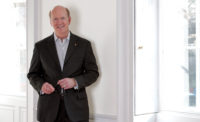Watching the presentations at this year’s Monterey Design Conference in northern California, attendees got a multiple-image portrait of architecture in the early 21st century. Elegant buildings with refined details alternated with exuberant installations that relied on digital know-how and student labor. Snapshots from Arkansas, Minnesota, and California appeared between reports from France, Japan, and Brazil. And a tribal elder told stories of working with Louis Kahn, as newer members of the profession listened raptly. More than 600 people gathered at the Asilomar Conference Grounds in Pacific Grove at the end of September for the event, which is presented every other year by the AIA California Council.
“We build between the parameters of the everyday and the world we imagine,” said Marlon Blackwell, whose graceful yet often-inexpensive projects have garnered international attention for the Fayetteville, Arkansas-based architect. “We work between the ideal and the improvised.” Like Blackwell, architects Anne Fougeron from San Francisco and Jennifer Yoos from VJAA in Minneapolis showed projects that drew deeply from their particular locations while transcending their regional roots. In her introduction of Blackwell, Record Editor in Chief Cathleen McGuigan said, “I realized how dated and useless certain terms have become, phrases such as ‘vernacular architecture’ or ‘regional modernism.’ The values embodied in Marlon’s work should be at the core of architecture everywhere.” The same could be said for the work of Fougeron and Yoos.
In a talk entitled “Outside In: Architecture in the Landscape,” Tom Phifer started with an image of a work by artist Dan Graham, a piece that is both transparent and reflective. Many of Phifer’s projects, including his Brochstein Pavilion at Rice University and his North Carolina Museum of Art, play with the same kind of duality, using materials such as glass and metals that can be clear, opaque, or reflective, depending on the time of day and direction of the sun.
Born in Brittany on the Atlantic coast of France, Odile Decq discussed the similarities between sailing and practicing architecture. “As a sailor, you must negotiate between the wind, the sea, and the boat. As an architect, you need to do the same kind of thing, but between the client, the contractor, and your own ideas.” She showed an impressive range of projects from L’Opera restaurant in the Palais Garnier opera house in Paris to her FRAC Bretagne and an unbelievably sexy sailing yacht.
Working with the forces of nature was also a theme for Kengo Kuma. After showing some images he took of the devastation inflicted by the March 2011 earthquake and tsunami in Japan, he said that in the 20th century his country had forgotten the lessons embodied by traditional Japanese architecture. In projects such as the Bato Hiroshige Museum in Tochigi Prefecture and an Adobe Repository for a Buddha Statue in Yamaguchi Prefecture, he worked with local materials and craftsmen to create modern buildings that transcend time.
Marcio Kogan and Suzana Glogowski of Studio MK27 from São Paulo entertained the crowd with a series of short films and images of their work. Witty and smart, the film clips humanized the strong, Modernist boxes that the firm designs. The architects also discussed themes such as silence, voyeurism, and emptiness found in their work.
A different kind of film kicked off a conversation between Richard Koshalek, the former director of the Hirshhorn Museum in Washington, D.C, and Robert Ivy, CEO of the American Institute of Architects. The film looked at artist Doug Aitkin’s work Song 1, a multimedia piece of music and moving images projected onto the outside of the Hirshhorn’s cylindrical Gordon Bunshaft-designed building, in the spring of 2012. Koshalek, who commissioned the work, and Ivy discussed the challenges and rewards of creating such a monumental piece of public art, especially in a town known for its conservative tastes in culture.
The spoken word proved its strength in a dialogue between John E. “Jack” MacAllister, who had worked for Kahn for many years, and Tim Culvahouse, editor of AIACC. MacAllister outlined 10 lessons he has learned in 60 years of practice, including “Distinguish between ‘Want’ and ‘Need,’” “Challenge Conventional Wisdom,” “Empower Younger Architects,” and “Make Yourself Interesting.” Seeded among all the established architects, a line-up of four emerging firms from California showed some new directions in which the profession is headed. Brian Price of Price Studio, Jason Kelly Johnson and Nataly Gattegno of Future Cities Lab, Dwayne Oyler and Jenny Wu of Oyler Wu Collaborative, and David Freeland and Brennan Buck of Freeland Buck presented mostly small-scale work, much of it temporary and informed by digital technologies.
Immediately following Yoos show of VJAA’s elegantly minimalist designs, Freeland and Buck proudly declared their penchant for a “maximalist” approach to architecture that’s digitally driven and messy. How much lasting impact such work may have has yet to be determined, but the contrast couldn’t have been starker.






